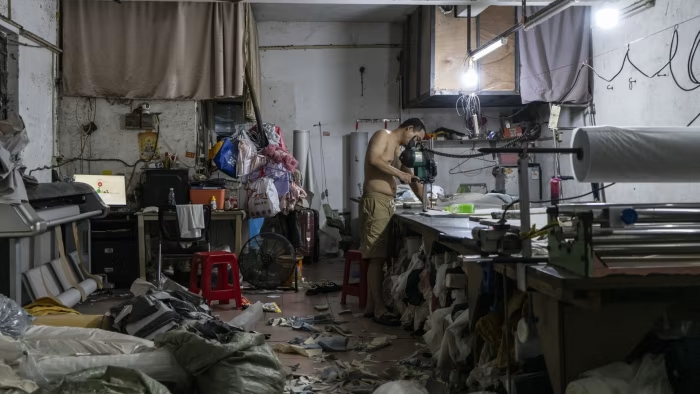Every morning, Zhou sifts his way through the crowds of hopeful workers, factory owners and snake oil sellers that throng the open air labour market in Datang, Guangzhou in the hope of finding suitable work.
Wading into a crowd of hopefuls surrounding a clothing factory manager perched on a bicycle one day last month, he picks up the half-finished lace top on display, weighs it in his hands and shakes his head: the pay per item is too low for a work that intricate.
Zhou, who declined to give a full name, is one of at least 200mn people in China working in the “gig economy”, a growing, informal sector of the labour market that spans everything from delivery drivers to construction workers. And while China’s fast fashion industry has long relied on nimble day labourers like Zhou, analysts say the increasing use of short-term labour in manufacturing is harming the country’s human capital and putting workers at risk.
“We’re a new generation of workers with a new generation of thinking,” says Zhou, a wiry and moustachioed worker in his 30s who moved to the garment production hub of Guangzhou eight years ago from the central province of Hubei. Although more flexible, he ends up working 12 hours a day, often seven days a week. “We wake up, work, finish work, sleep: it’s a two-point line.”
Officially, Chinese companies are only supposed to employ a maximum 10 per cent of their staff on a short-term basis. But analysts say that in recent years, the proportion of temporary workers in the manufacturing sector has crept up, making life more precarious for a huge swath of the workforce and undermining labourers’ ability to learn new skills.
For instance, a study by Peking University academic Zhang Dandan estimated that there were approximately 40mn short-term workers in the manufacturing sector by 2024, or about 31 per cent of the total. Previous surveys from five provinces suggested that the proportion of flexible workers was 20 per cent in 2017, after exhibiting a “significant upward trend” in the previous seven years, she wrote.
Many Chinese factory workers are employed in long-term, full-time roles and sometimes remain at individual factories for decades. Under such conditions, they are entitled to workplace and health insurance, protection from unfair dismissal, a degree of training and, after a certain period of service, retirement and other benefits.
Hiring temporary workers, either through contract labour agencies or via open air markets such as the one in Datang, can give factory managers more flexibility and lower costs by reducing payments for training and other benefits. For workers, it can mean greater choice over where to work and, in the short term, higher pay, as many receive bonuses for completing stints at each plant.
But it also leaves them exposed. Most day workers and many agency labourers do not have contracts or workplace insurance and are clustered in the most low-skilled part of the production process, such as the final assembly of electronics.
Analysts warn that the funnelling of large numbers of workers into tedious jobs that offer little chance of training or career advancement could create a skills deficit in the future and impede social mobility.
“Contract labour becomes this very convenient way of just having this flexibility without the risk of any long-term commitments, without the risks of paying compensation, or the difficulties of firing people,” says Dmitri Kessler, founder of the Economic Rights Institute.
Kessler says that using short-term labourers in electronics manufacturing also allows factories quickly to replace workers hurt when performing physically arduous tasks or exposed to harmful activities. “From our perspective, it’s extremely problematic,” he says.
31%
Estimated share of short-term workers in manufacturing sector by 2024
Moreover, because hourly wages for temporary roles are often higher than for fixed work — though still cost the employer less given reduced additional benefits — many workers end up opting for short-term roles with little prospect of advancement and do not care about the companies they work for.
“You develop a kind of a dependence on the most base level of employment . . . that has an impact on the productivity of the workers themselves,” says Kessler.
Jenny Chan, a sociologist at the Hong Kong Polytechnic University, says that some factories can employ as many as 70 per cent of their workers on a temporary basis during peak seasons, although an absolute number is difficult to pin down. “This is definitely a more precarious, very fluid form of labour,” she says.
The proportion of workers employed on a temporary basis has increased since about 2008, following both the global financial crisis and China’s introduction of a stricter labour law that offers greater protections to full-time workers, she says.
As the growing usage started to attract greater government scrutiny, some factories turned to the country’s network of vocational schools to send trainees or interns to meet their staffing needs. Renewed scrutiny of the use of vulnerable student workers has only pushed the practice underground, she says. “They have been continuing the practice . . . they just made it more difficult to identify.”
Mo, a temporary garment factory worker in his 30s who declined to give a full name, says he went through a variety of short-term roles in the services sector before arriving in the Datang garment manufacturing district to find work.
Nowadays, he adds, outside of the most skilled jobs, lots of employment in China is offered on a flexible basis.
“You just make yourself OK from one day to the next. But if you want to get married, have a family, you definitely can’t think like this,” Mo says of his life as a day labourer while he peruses yellow posters advertising roles in Datang. “Doing this kind of work is a rotten state of affairs.”
